- with readers working within the Business & Consumer Services and Law Firm industries
- within Cannabis & Hemp topic(s)
In the Old Testament, King Solomon proposed to resolve a dispute between two women who both claimed to be the mother of an infant by declaring that the baby should be cut in two, with each woman receiving half. When one mother immediately objected and begged Solomon to give the baby to the other woman to save its life, Solomon determined that she was the true mother and awarded her custody.
In a trademark dispute involving the ownership of a trademark, the U.S. Court of Appeals for the Second Circuit recently "split the baby" and affirmed a jury verdict that the ZIONESS trademark is jointly owned by two separate nonprofit organizations—Zioness Movement Inc. (ZMI) and The Lawfare Project Inc. (LPI).
The decision provides useful lessons concerning trademark co-ownership, a concept that is disfavored in the law because it is contrary to the fundamental principle that a trademark identifies and distinguishes a single source of goods or services.
Background
In 2017, LPI, a nonprofit organization whose primary mission is to "defend the civil and human rights of the Jewish community," launched the Zioness initiative to combat anti-Zionist sentiment. LPI sought to create some distance between the new initiative and its own brand and funded the creation of the ZIONESS brand identity, including its logo, website, and merchandise. Amanda Berman, then LPI's director of legal affairs, led the movement's public-facing efforts. Over time "the distance between the Zioness movement and LPI grew." In 2018, after LPI ceased providing financial support to the Zioness initiative and while still employed by LPI, Berman formed ZMI as a separate nonprofit entity using her own funds. ZMI applied to register the ZIONESS trademark with the U.S. Patent and Trademark Office (USPTO).
In 2020, more than one year after Berman had left LPI, the application matured to registration. LPI petitioned to cancel the registration at the USPTO's Trademark Trial and Appeal Board (TTAB). ZMI responded by filing a lawsuit in federal court seeking a declaratory judgment of sole ownership. LPI countersued, claiming that it owned the mark. Following an eight-day trial, the jury found that both entities were co-owners of the mark. ZMI appealed the verdict to the Second Circuit Court of Appeals, arguing that co-ownership was fundamentally incompatible with trademark law's basic principles and lacked evidentiary support.
The Appellate Decision
The Second Circuit effectively "split the baby" rejecting ZMI's appeal and affirming the jury's finding of joint ownership. The Court found that there was sufficient evidence to support the jury's verdict that both ZMI and LPI own the ZIONESS trademark noting that "LPI spearheaded the creation of the mark, including paying for its initial design and development." The Court did not address ZMI's argument that co-ownership was contrary to basic principles of trademark law, finding that ZMI failed to timely object to (1) the verdict sheet, which explicitly contemplated a potential verdict of co-ownership, and (2) the jury's verdict of co-ownership before the jury was excused.
The Court concluded that ZMI did not establish the "fundamental error" required to reverse the verdict, citing to a section of the Trademark Act, 15 U.S.C. § 1052(d), which permits "concurrent" registrations when a court determines that multiple parties are entitled to use the same or similar marks in commerce. The Court focused on the contributions of the dueling parties to the design and development of the mark, rather than the likelihood of consumer confusion. It did not focus on which party first used the mark or which party exercised quality control over the nature and quality of the services on which the mark appeared, among other factors courts often weigh in trademark ownership disputes.
Zioness Movement, Inc. v. the Lawfare Project, Inc., 24 civ. 974 (2d Cir. August 13, 2025)
Author's Note:
Trademark law is built on the premise that a mark signifies a single source and courts generally avoid "splitting the baby" based solely on the contributions the parties have made to the development of a mark because co-ownership can contradict the Lanham Act's emphasis on exclusive rights and clear source identification. According to J. Thomas McCarthy, "When there is a dispute over who owns a trademark, the worst possible solution is to allow mark ownership to be shared among the warring parties. Fragmentation of ownership is to be avoided, both by contract and by judicial fiat." McCarthy on Trademarks and Unfair Competition, § 16:40 (5th ed. 2023) (citation omitted). When more than one entity provides services under the same mark it can lead to customer confusion and deception.
Moreover, co-ownership can impair the value of the mark itself. Inconsistent control of the quality of goods or services under a shared mark may undermine its validity. Divergent messaging, branding, or quality standards can dilute a mark's distinctiveness. Also, enforcement and licensing can become complicated if there are disagreements between the co-owners.
While this decision was clearly fact-specific, it provides useful lessons for brand owners:
- Secure Written Assignments: When employees or independent contractors contribute to brand development, the employer should obtain written intellectual property assignments from each of them.
- Monitor Employment Overlap: If employees work for separate entities while still employed, employers should set clear intellectual property ownership parameters in their employment contracts and policies.
- Avoid Informal Arrangements: Employers and content creators should avoid verbal understandings or assumptions about intellectual property ownership.
- Establish Joint Quality Control: If co-ownership is unavoidable, the co-owners should establish a joint policy for maintaining quality control.
The content of this article is intended to provide a general guide to the subject matter. Specialist advice should be sought about your specific circumstances.


